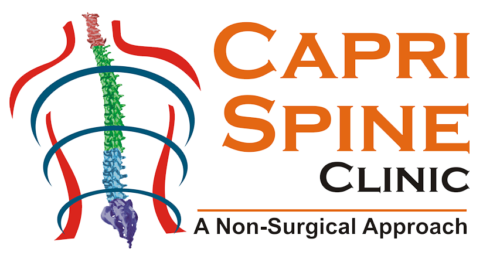Spinal Canal Stenosis
Best Spine Treatment Without Surgery for Spinal Canal Stenosis near you at Capri Spine
Cervical and Lumbar Canal Stenosis
Reduction in the diameter of the spinal canal can cause compression of the spinal thecal sac leading to neurological problems like numbness and pain. Flexion based exercises are best for this!
It is a narrowing of the open spaces within your spine, which can put pressure on your spinal cord and the nerves that travel through the spine. Spinal stenosis occurs most often in the neck and lower back. While some people have no signs or symptoms, spinal stenosis can cause pain, numbness, muscle weakness, and problems with bladder or bowel function.
Spinal stenosis is most commonly caused by wear-and-tear changes in the spine related to aging. In severe cases of spinal stenosis, doctors may recommend surgery to create additional space for the spinal cord or nerves.
Many people have evidence of spinal stenosis on X-rays, but have no signs or symptoms. When symptoms do occur, they often start gradually and worsen over time. Symptoms vary, depending on the location of the stenosis:
- In the neck. Narrowing in the upper (cervical) spine can cause numbness, weakness or tingling in a leg, foot, arm or hand. In severe cases, nerves to the bladder or bowel may be affected, leading to incontinence.
- In the lower back. Compressed nerves in your lower (lumbar) spine can cause pain or cramping in your legs when you stand for long periods of time or when you walk. The discomfort usually eases when you bend forward or sit down.
While some people are born with a small spinal canal, most spinal stenosis occurs when something happens to reduce the amount of space available within the spine. Causes of spinal stenosis may include:
- Overgrowth of bone. Wear and tear on your spinal bones can prompt the formation of bone spurs, which can grow into the spinal canal. Paget’s disease, a bone disease that usually affects adults, also can cause bone overgrowth in the spine.
- Herniated discs. The soft cushions that act as shock absorbers between your vertebrae tend to dry out with age. Cracks in a disk’s exterior may allow some of the soft inner material to escape and press on the spinal cord or nerves.
- Thickened ligaments. The tough cords that help hold the bones of your spine together can become stiff and thick over time. These thicker ligaments can bulge into the spinal canal.
- Tumors. Abnormal growths can form inside the spinal cord, within the membranes that cover the spinal cord or in the space between the spinal cord and vertebrae.
- Spinal injuries. Car accidents and other major trauma can cause dislocations or fractures of one or more vertebrae. Displaced bone from a spinal fracture may damage the contents of the spinal canal. Swelling of adjacent tissue immediately following back surgery also can put pressure on the spinal cord or nerves.

